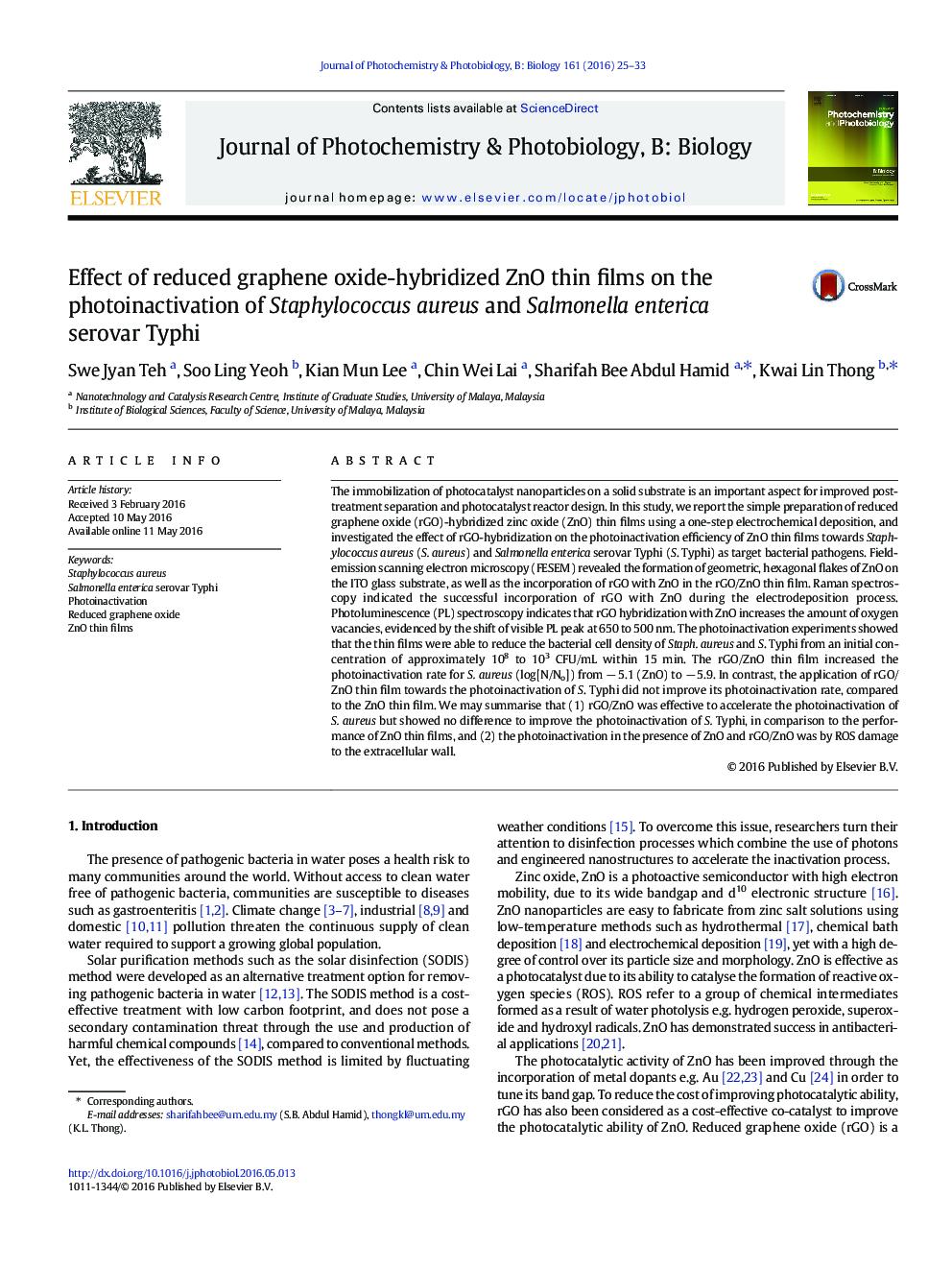| کد مقاله | کد نشریه | سال انتشار | مقاله انگلیسی | نسخه تمام متن |
|---|---|---|---|---|
| 6493639 | 44418 | 2016 | 9 صفحه PDF | دانلود رایگان |
عنوان انگلیسی مقاله ISI
Effect of reduced graphene oxide-hybridized ZnO thin films on the photoinactivation of Staphylococcus aureus and Salmonella enterica serovar Typhi
دانلود مقاله + سفارش ترجمه
دانلود مقاله ISI انگلیسی
رایگان برای ایرانیان
کلمات کلیدی
موضوعات مرتبط
مهندسی و علوم پایه
مهندسی شیمی
بیو مهندسی (مهندسی زیستی)
پیش نمایش صفحه اول مقاله

چکیده انگلیسی
The immobilization of photocatalyst nanoparticles on a solid substrate is an important aspect for improved post-treatment separation and photocatalyst reactor design. In this study, we report the simple preparation of reduced graphene oxide (rGO)-hybridized zinc oxide (ZnO) thin films using a one-step electrochemical deposition, and investigated the effect of rGO-hybridization on the photoinactivation efficiency of ZnO thin films towards Staphylococcus aureus (S. aureus) and Salmonella enterica serovar Typhi (S. Typhi) as target bacterial pathogens. Field-emission scanning electron microscopy (FESEM) revealed the formation of geometric, hexagonal flakes of ZnO on the ITO glass substrate, as well as the incorporation of rGO with ZnO in the rGO/ZnO thin film. Raman spectroscopy indicated the successful incorporation of rGO with ZnO during the electrodeposition process. Photoluminescence (PL) spectroscopy indicates that rGO hybridization with ZnO increases the amount of oxygen vacancies, evidenced by the shift of visible PL peak at 650 to 500 nm. The photoinactivation experiments showed that the thin films were able to reduce the bacterial cell density of Staph. aureus and S. Typhi from an initial concentration of approximately 108 to 103 CFU/mL within 15 min. The rGO/ZnO thin film increased the photoinactivation rate for S. aureus (log[N/No]) from â 5.1 (ZnO) to â 5.9. In contrast, the application of rGO/ZnO thin film towards the photoinactivation of S. Typhi did not improve its photoinactivation rate, compared to the ZnO thin film. We may summarise that (1) rGO/ZnO was effective to accelerate the photoinactivation of S. aureus but showed no difference to improve the photoinactivation of S. Typhi, in comparison to the performance of ZnO thin films, and (2) the photoinactivation in the presence of ZnO and rGO/ZnO was by ROS damage to the extracellular wall.
ناشر
Database: Elsevier - ScienceDirect (ساینس دایرکت)
Journal: Journal of Photochemistry and Photobiology B: Biology - Volume 161, August 2016, Pages 25-33
Journal: Journal of Photochemistry and Photobiology B: Biology - Volume 161, August 2016, Pages 25-33
نویسندگان
Swe Jyan Teh, Soo Ling Yeoh, Kian Mun Lee, Chin Wei Lai, Sharifah Bee Abdul Hamid, Kwai Lin Thong,